Happy Birthday! Inventory of the top 10 beautiful space pictures taken by Hubble
Pillars of Creation / The Eagle Nebula[1]
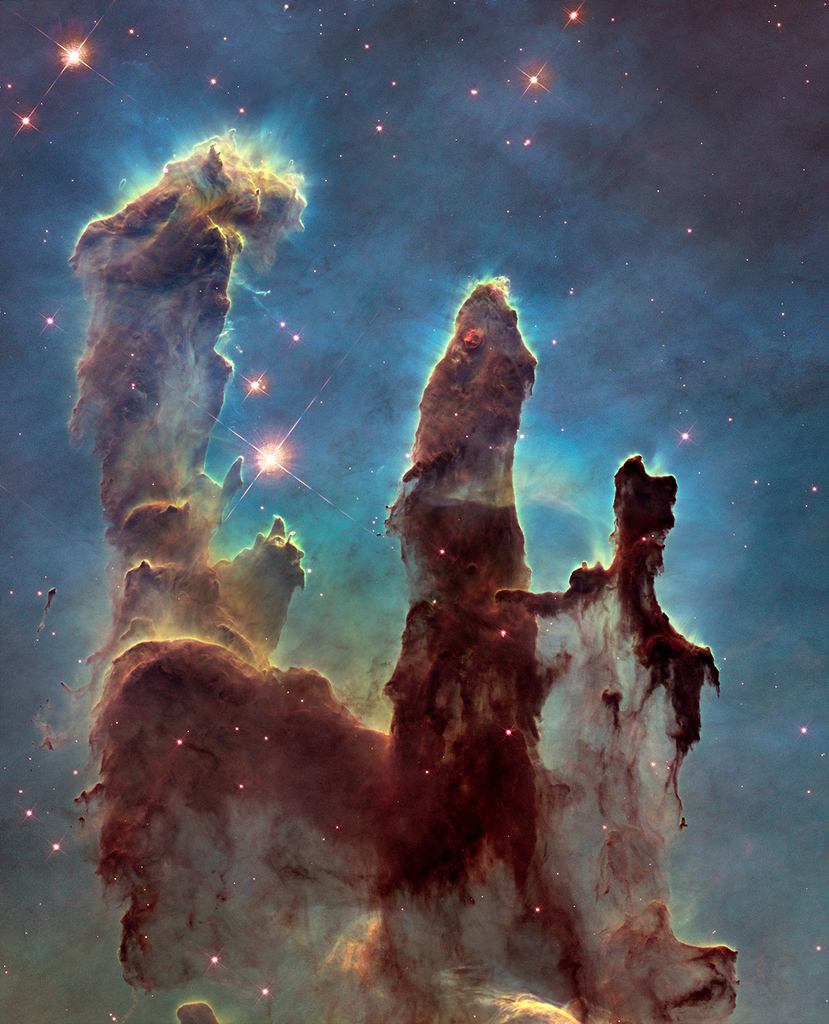
Pillars of Creation / The Eagle Nebula
From afar, the whole thing looks like an Eagle. A closer look at the Eagle Nebula, however, shows the bright region is actually a window into the center of a larger dark shell of dust. Through this window, a brightly-lit workshop appears where a whole open cluster of stars is being formed. In this cavity tall pillars and round globules of dark dust and cold molecular gas remain where stars are still forming. Already visible are several young bright blue stars whose light and winds are burning away and pushing back the remaining filaments and walls of gas and dust. The Eagle emission nebula, tagged M16, lies about 6500 light years away, spans about 20 light-years, and is visible with binoculars toward the constellation of Serpens. The above picture combines three specific emitted colors and was taken with the 0.9-meter telescope on Kitt Peak, Arizona, USA.
God’s Eye / The Helix Nebula[2]
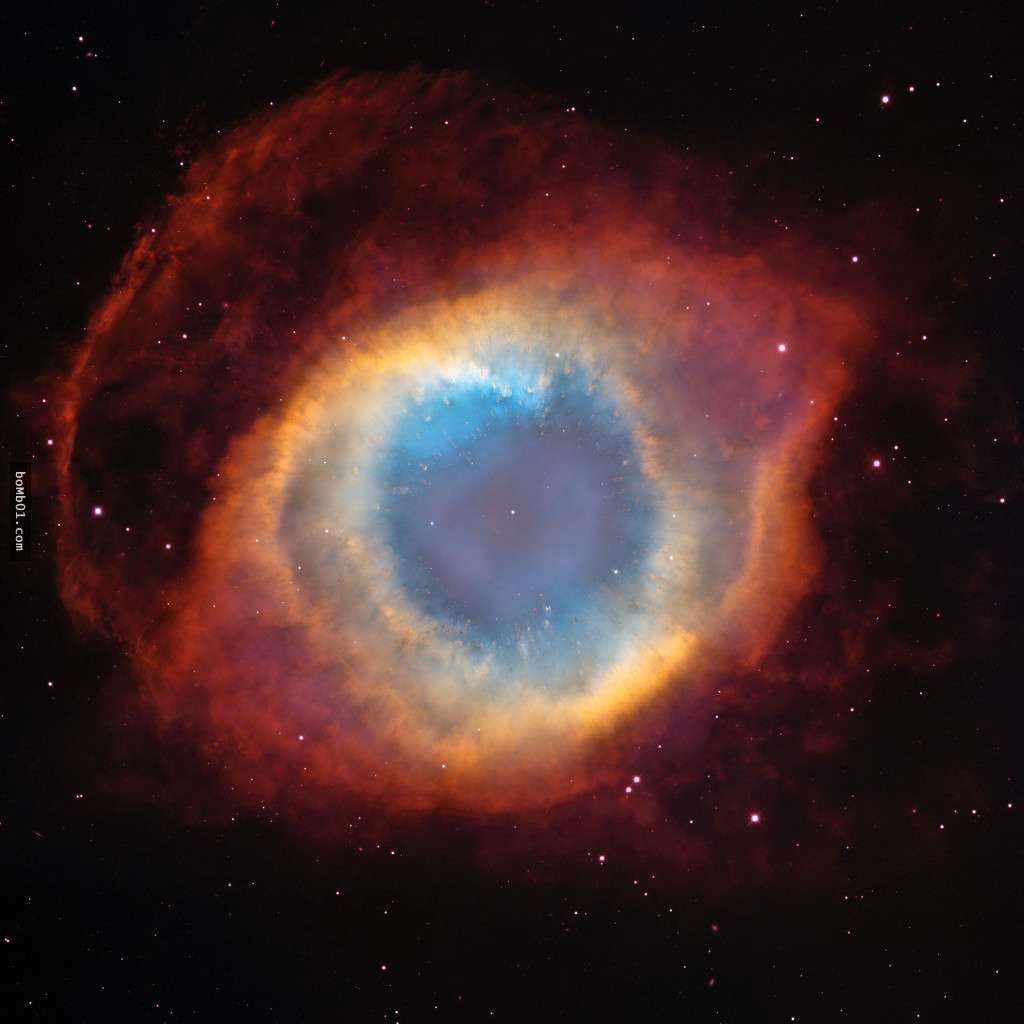
God’s Eye / The Helix Nebula
A mere seven hundred light years from Earth, in the constellation Aquarius, a sun-like star is dying. Its last few thousand years have produced the Helix Nebula (NGC 7293), a well studied and nearby example of a Planetary Nebula, typical of this final phase of stellar evolution. Nearly 11 hours of exposure time have gone in to creating this remarkably deep view of the nebula. It shows details of the Helix’s brighter inner region, about 3 light-years across, but also follows fainter outer halo features that give the nebula a span of well over six light-years. The white dot at the Helix’s center is this Planetary Nebula’s hot, central star. A simple looking nebula at first glance, the Helix is now understood to have a surprisingly complex geometry.
The Crab Nebula[3]
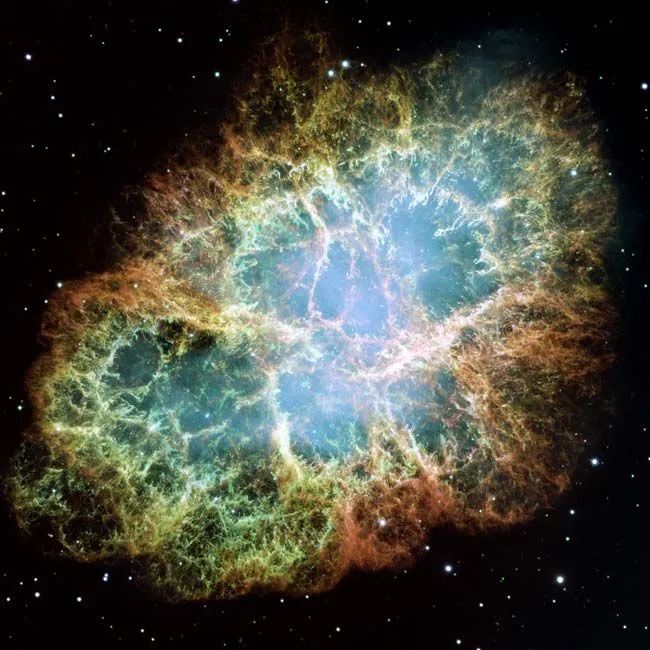
The Crab Nebula
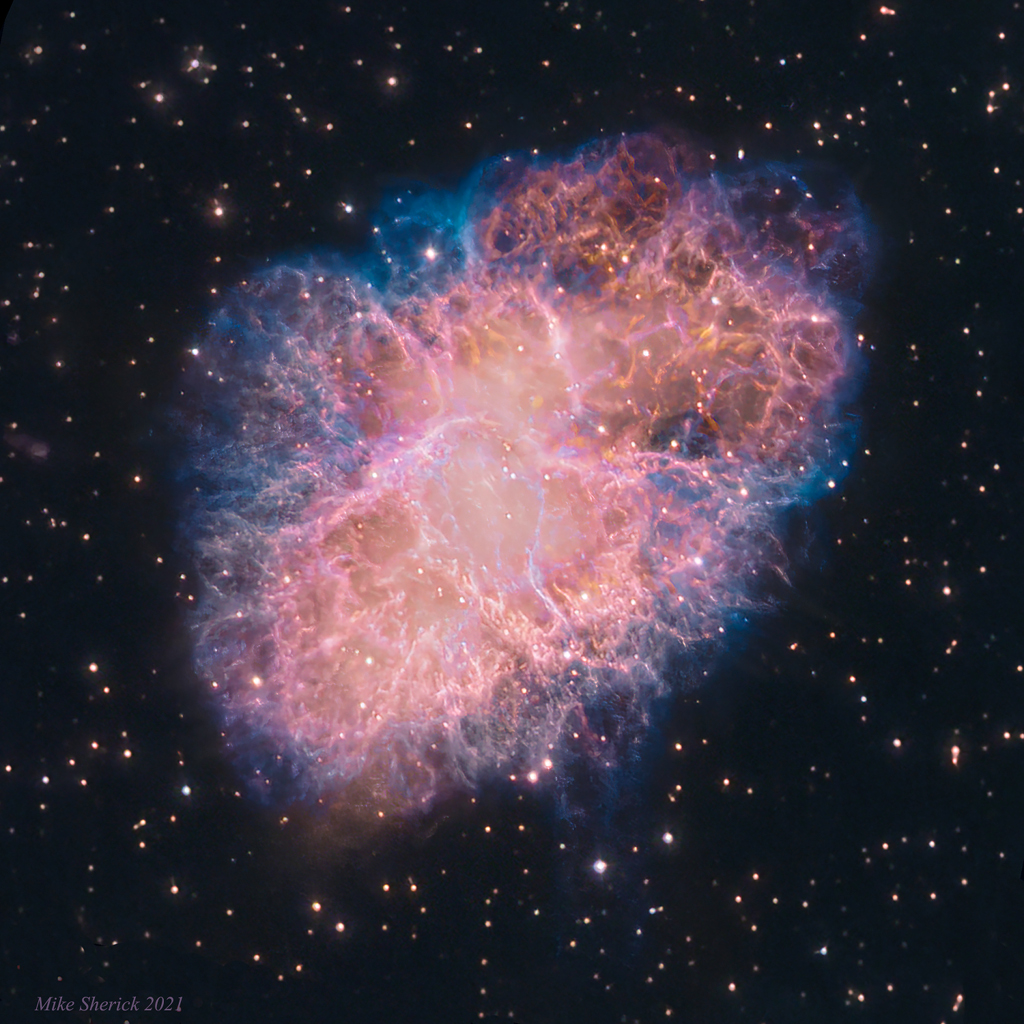
The Crab Nebula
This is the mess that is left when a star explodes. The Crab Nebula, the result of a supernova seen in 1054 AD, is filled with mysterious filaments. The filaments are not only tremendously complex, but appear to have less mass than expelled in the original supernova and a higher speed than expected from a free explosion. The above image, taken by the Hubble Space Telescope, is presented in three colors chosen for scientific interest. The Crab Nebula spans about 10 light-years. In the nebula’s very center lies a pulsar: a neutron star as massive as the Sun but with only the size of a small town. The Crab Pulsar rotates about 30 times each second.
The Butterfly Nebula[4]
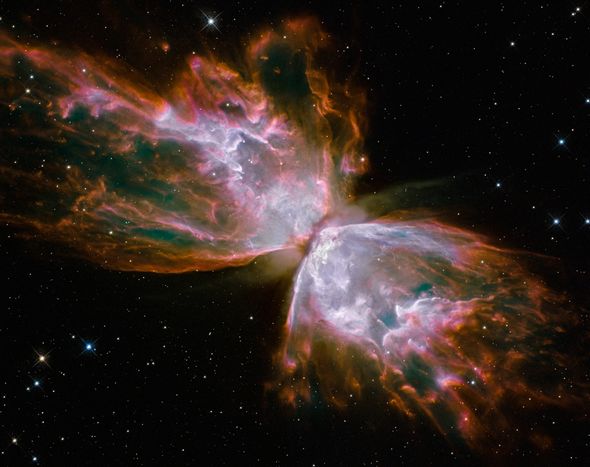
The Butterfly Nebula
Few butterflies have a wingspan this big. The bright clusters and nebulae of planet Earth’s night sky are often named for flowers or insects, and NGC 6302 is no exception. With an estimated surface temperature of about 250,000 degrees C, the central star of this particular planetary nebula is exceptionally hot though — shining brightly in ultraviolet light but hidden from direct view by a dense torus of dust. This dramatically detailed close-up of the dying star’s nebula was recorded by the Hubble Space Telescope soon after it was upgraded in 2009. Cutting across a bright cavity of ionized gas, the dust torus surrounding the central star is near the center of this view, almost edge-on to the line-of-sight. Molecular hydrogen has been detected in the hot star’s dusty cosmic shroud. NGC 6302 lies about 4,000 light-years away in the arachnologically correct constellation of the Scorpion (Scorpius).
The Horsehead Nebula[5]
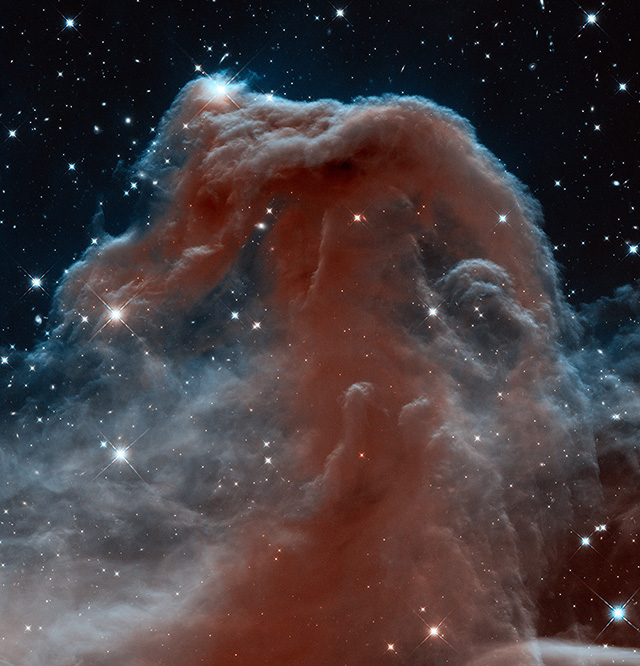
The Horsehead Nebula
The Horsehead Nebula is one of the most famous nebulae on the sky. It is visible as the dark indentation to the red emission nebula seen above and to the right of center in the above photograph. The bright star on the left is located in the belt of the familiar constellation of Orion. The horse-head feature is dark because it is really an opaque dust cloud which lies in front of the bright red emission nebula. Like clouds in Earth’s atmosphere, this cosmic cloud has assumed a recognizable shape by chance. After many thousands of years, the internal motions of the cloud will alter its appearance. The emission nebula’s red color is caused by electrons recombining with protons to form hydrogen atoms. Also visible in the picture are blue reflection nebulae, which preferentially reflect the blue light from nearby stars.
The death of NGC 5189[6]
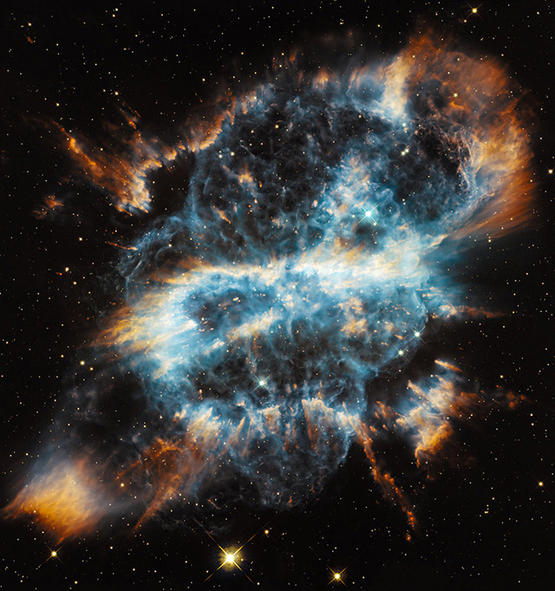
The death of NGC 5189
After a Sun-like star can no longer support fusion in its core, the center condenses into a white dwarf while the outer atmospheric layers are expelled into space and appear as a planetary nebula. This particular planetary nebula has a quite strange and chaotic structure. The inner part of this nebula contains an unusual expanding ring of gas that we see nearly edge-on. The exact mechanism that expels the planetary nebula gas is a current topic of astronomical speculation and research.
Perfect Disk / The Sombrero Galaxy[7]
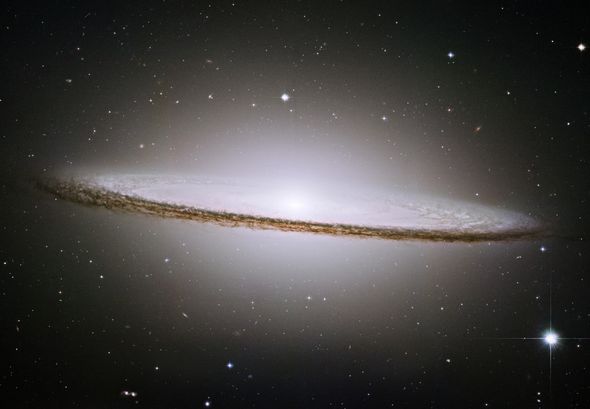
Perfect Disk / The Sombrero Galaxy
The striking spiral galaxy M104 is famous for its nearly edge-on profile featuring a broad ring of obscuring dust lanes. Seen in silhouette against an extensive central bulge of stars, the swath of cosmic dust lends a broad brimmed hat-like appearance to the galaxy suggesting a more popular moniker, The Sombrero Galaxy. Hubble Space Telescope data have been used to create this sharp view of the well-known galaxy. The processing results in a natural color appearance and preserves details often lost in overwhelming glare of M104’s bright central bulge when viewed with smaller ground-based telescopes. Also known as NGC 4594, the Sombrero galaxy can be seen across the spectrum and is host to a central supermassive black hole. About 50,000 light-years across and 28 million light-years away, M104 is one of the largest galaxies at the southern edge of the Virgo Galaxy Cluster.
In the Center of 30 Doradus[8]
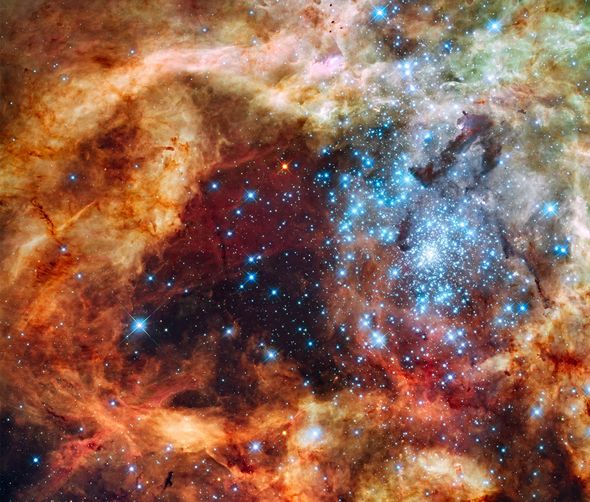
In the Center of 30 Doradus
In the center of 30 Doradus lies a huge cluster of the largest, hottest, most massive stars known. The center of this cluster, known as R136, is boxed in the upper right portion of the above picture. The gas and dust filling the rest of the picture is predominantly ionized hydrogen from the emission nebula 30 Doradus. R136 is composed of thousands of hot blue stars, some about 50 times more massive than our Sun. 30 Doradus and R136 lie in the LMC – a satellite galaxy to our own Milky Way Galaxy. Although the ages of stars in R136 cause it to be best described as an open cluster, R136’s density will likely make it a low mass globular cluster in a few billion years.
Massive Stars in Open Cluster Pismis 24[9]
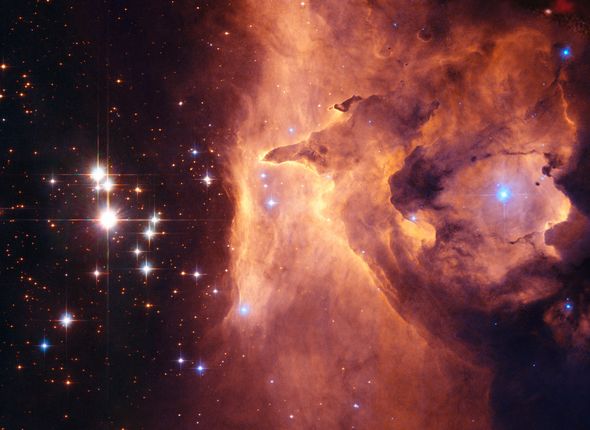
Massive Stars in Open Cluster Pismis 24
How massive can a normal star be? Estimates made from distance, brightness and standard solar models had given one star in the open cluster Pismis 24 over 200 times the mass of our Sun, making it a record holder. This star is the brightest object located just to the right of the gas front in the above image. Close inspection of images taken recently with the Hubble Space Telescope, however, have shown that Pismis 24-1 derives its brilliant luminosity not from a single star but from three at least. Component stars would still remain near 100 solar masses, making them among the more massive stars currently on record. Toward the image left, stars are still forming in the associated emission nebula NGC 6357, including several that appear to be breaking out and illuminating a spectacular cocoon.
Hubble
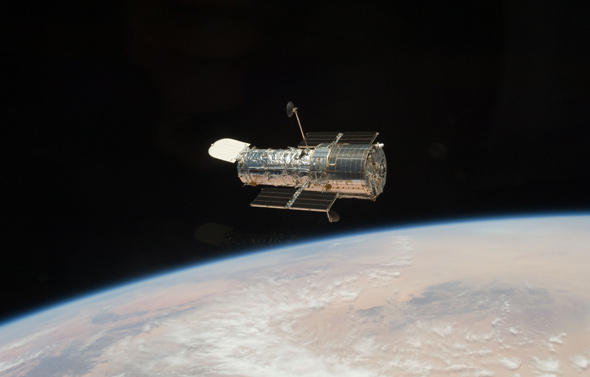
Hubble
Our birthday star is of course the best looking!
During the STS-125 mission, the space shuttle “Atlantis” docked with the Hubble Space Telescope for a week. After the mission ended on May 19, 2009, during the relative displacement of the two spacecraft, ” The crew of Atlantis captured this Hubble Space Telescope image above Earth. During that week, astronauts performed five spacewalks to perform one final repair on the Hubble Space Telescope.
Other
The editor thinks the following pictures are beautiful too!
The Quintuplet Star Cluster[10]
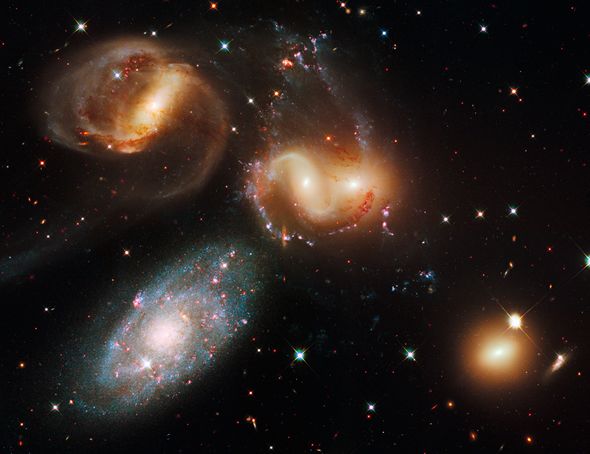
The Quintuplet Star Cluster
Bright clusters of stars form and disperse near the center of our Galaxy. Four million years ago the Quintuplet Cluster, pictured above, formed and is now slowly dispersing. The Quintuplet Cluster is located within 100 light-years of the Galactic center, and is home to the brightest star yet cataloged in our Galaxy: the Pistol Star. Objects near our Galactic center are usually hidden from view by opaque dust. This recently-released picture was able to capture the cluster in infrared light, though, with the NICMOS camera onboard the orbiting Hubble Space Telescope. The young Quintuplet Cluster is one of the most massive open clusters yet discovered, but still much less massive than the ancient globular clusters that orbit in the distant halo. Some of the bright white stars visible above may be on the verge of blowing themselves up in a spectacular supernova.
The Red Spider Planetary Nebula[11]
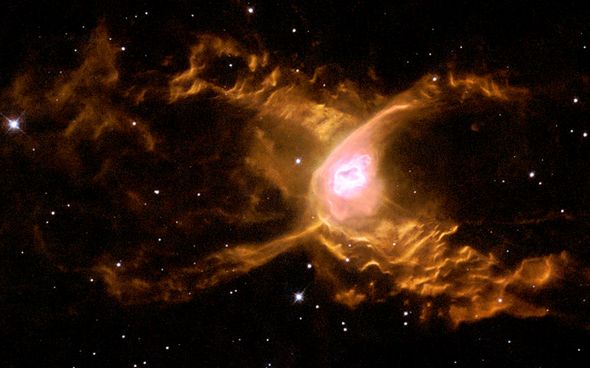
The Red Spider Planetary Nebula
Oh what a tangled web a planetary nebula can weave. The Red Spider Planetary Nebula shows the complex structure that can result when a normal star ejects its outer gases and becomes a white dwarf star. Officially tagged NGC 6537, this two-lobed symmetric planetary nebula houses one of the hottest white dwarfs ever observed, probably as part of a binary star system. Internal winds emanating from the central stars, visible in the center, have been measured in excess of 1000 kilometers per second. These winds expand the nebula, flow along the nebula’s walls, and cause waves of hot gas and dust to collide. Atoms caught in these colliding shocks radiate light shown in the above representative-color picture by the Hubble Space Telescope. The Red Spider Nebula lies toward the constellation of the Archer (Sagittarius). Its distance is not well known but has been estimated by some to be about 4,000 light-years.
Movie Recommendations
What it says: “It was an indescribable beauty. I looked at the brooding stars in the Orion Nebula and saw the dying stars as beautiful as butterflies. I looked through billions of galaxies and saw hundreds of The light from billions of years ago—that’s the farthest I can go. All these moments will be lost in time, like tears in rain. The hour of death has come.”
——《Hubble 3D》
Reference article:
[1]APOD: 2004 October 24 – Inside the Eagle Nebula (nasa.gov)
[2]APOD: 2007 August 3 – NGC 7293: The Helix Nebula (nasa.gov)
[3]APOD: 2009 October 25 -M1: The Crab Nebula from Hubble (nasa.gov)
[4]APOD: 2011 November 13 – The Butterfly Nebula from Hubble (nasa.gov)
[5]APOD: 2005 March 21 – Orion’s Horsehead Nebula (nasa.gov)
[6]APOD: December 11, 1995 – NGC 5189: A Strange Planetary Nebula (nasa.gov)
[7]APOD: 2019 March 29 – M104: The Sombrero Galaxy (nasa.gov)
[8]APOD: May 24, 1996 – In the Center of 30 Doradus (nasa.gov)
[9]APOD: 2006 December 19 – Massive Stars in Open Cluster Pismis 24 (nasa.gov)
[10]APOD: September 21, 1999 – The Quintuplet Star Cluster (nasa.gov)
[11]APOD: 2017 April 19 – The Red Spider Planetary Nebula (nasa.gov)

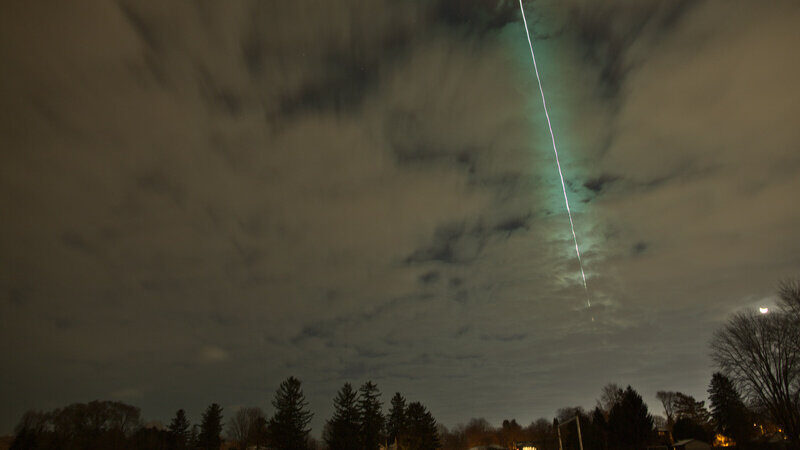

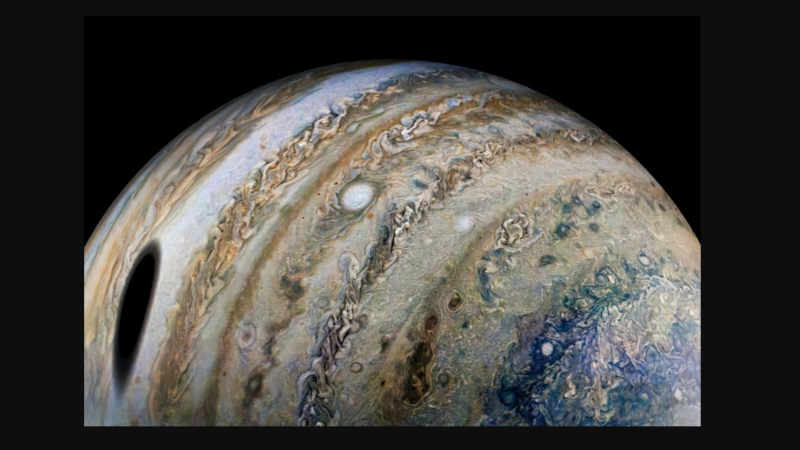
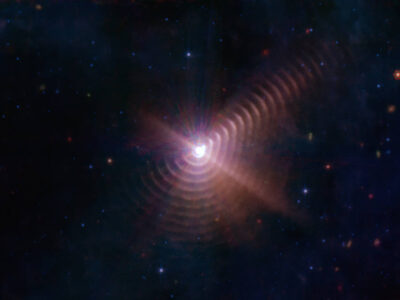
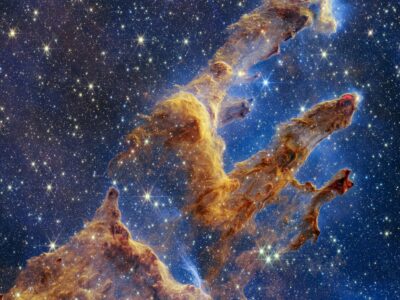
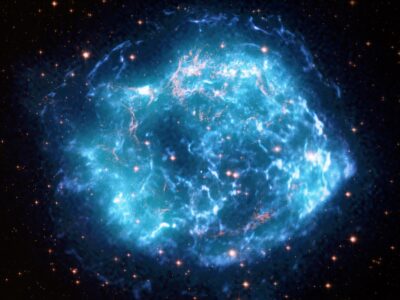
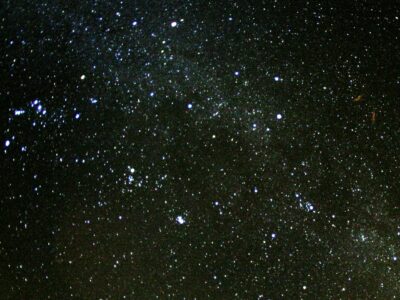



Pillars of Creation is soooooooooo beautiful